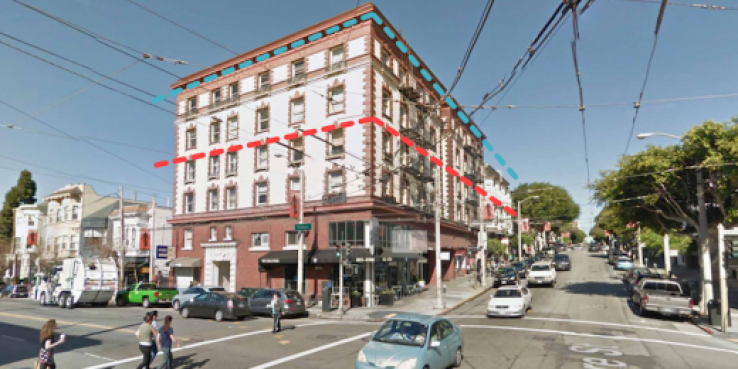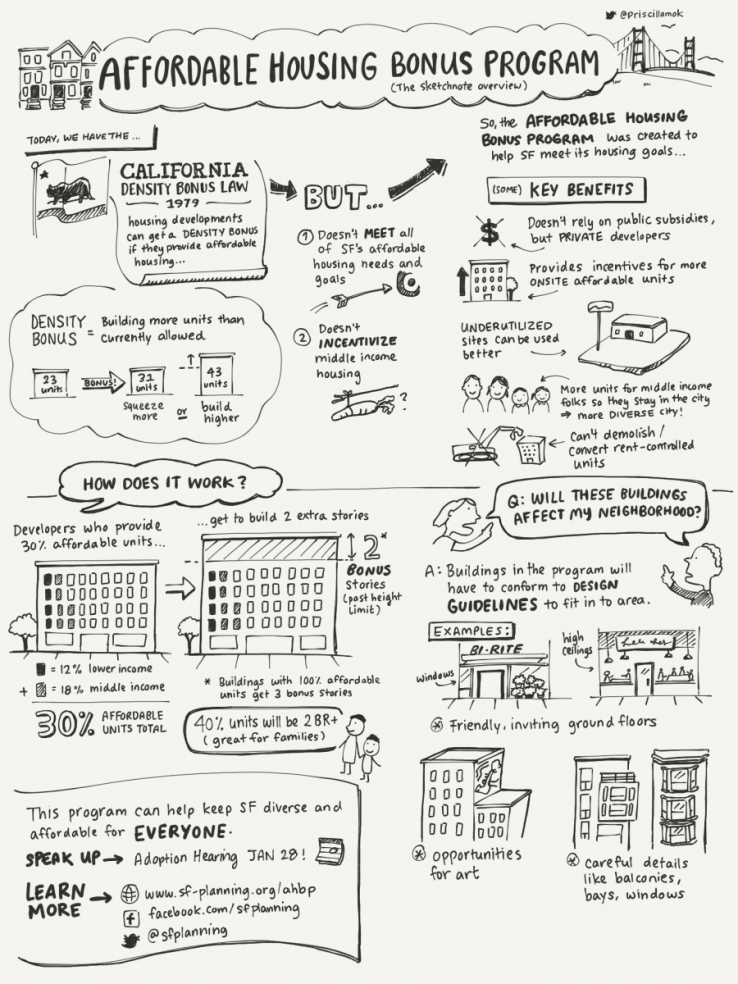Listening to some San Francisco advocates, it’s easy to get the impression that the proposed Affordable Housing Bonus Program (AHBP) will displace existing residents, eliminate public process and dramatically alter the city overnight. But this ignores two key factors. First, the program has been very thoughtfully crafted, over a long period of time, to create new affordable and market-rate housing without displacing anyone. Second, the length of the building cycle means these changes will happen gradually, over two decades or more.
This proposed program would provide incentives for developers to include more affordable housing for very low-, low-, moderate- and middle-income households within market-rate development projects. In exchange, the incentives would allow higher densities, increased heights, reduced numbers of parking spaces and flexibility on some zoning requirements. San Francisco’s program addresses a California state law from 1979 that requires all jurisdictions to have such a bonus program in place.
The AHBP is a complicated program, so it’s easy to see why it might be hard to make heads or tails of competing claims. Fortunately, staff members from the SF Planning Department have presented the AHBP in many public settings, and the program’s website provides a deep repository of detailed information and analysis that can help people understand the program better.
This sketch by Priscilla Mok also helps clarify the picture:
Illustration by Priscilla Mok
Overall, SPUR believes the Affordable Housing Bonus Program will provide long-term opportunities for increasing the city’s housing supply. While the city’s analysis touts that the program could create 16,000 units on 240 sites, it’s also estimated to take 20 years. Building 800 new units a year across a city of San Francisco’s size is not a drastic move. And with the land values and construction costs of today’s market, the program is unlikely to be heavily used in the near term. Developers we’ve spoken with are intrigued by the program concept and have run the numbers — but they aren’t sure why they would opt to use it right now, when costs are at their peak. The density bonus and other incentives simply do not make up for the lower rents on the additional affordable units. Sad to say, and contrary to what some believe, this program is more likely to affect the next real estate cycle. We strongly believe that the city should implement the program now, but San Francisco’s collective best expectations and worst fears are unlikely to pan out.
One of the criticisms against the program is that it would displace current residents. This is an important concern and deserves analysis. Supervisor London Breed has proposed an amendment (supported by Mayor Ed Lee and Supervisor Katy Tang, the AHBP legislation’s sponsors) that prohibits demolishing, removing or converting any rent-controlled units until the Planning Department completes a study of the relationship between this program and the city’s rent-controlled and affordable housing stock. Per the amendment, the Planning Commission will have to recommend subsequent modifications to the Board of Supervisors by January 1, 2017. There have been some complaints that the proposed amendment is not permanent, and yet the prohibition on sites with rent-controlled units would remain in place indefinitely unless the Planning Commission and Board of Supervisors approve changes to the program.
There are also concerns about whether the bonus program would circumvent the existing public process for new buildings. The AHBP does not eliminate public process or the opportunity for neighbors to speak out. All projects, no matter the size, would still be required to hold a public hearing for concerned citizens to voice their opinions. Similarly, Planning Commission decisions would still be appealable, though to the Board of Appeals rather than the Board of Supervisors. Anyone who follows SPUR’s work knows that we care about the approvals process and want to make it simpler and more straightforward for good housing projects. On this point, SPUR is not satisfied because we believe AHBP projects should be expedited.
We need to remember that there is a state density bonus law, and San Francisco should comply. The city created this Affordable Housing Bonus Program to tailor program requirements to San Francisco’s planning context and community needs. If this legislation is not enacted, the city may end up in a worse place overall, with developers accessing the state density program’s incentives simply by complying with San Francisco’s baseline affordable housing requirements.
We see this as a long game, but an important one. We believe that the AHBP will create more housing, at multiple levels of affordability, for San Franciscans new and old. In the absence of efforts to grow the city’s housing stock, housing will simply become more precious and more expensive. There are those who don’t believe market-rate housing has a role to play in solving the affordability crisis. But SPUR believes supply and demand work together in the long run. In fact, recent data shows that market-rate rents have dipped slightly, likely due to recent development. This means San Francisco needs to increase the overall housing supply — not only the affordable housing restricted to low- and moderate-income households. Creating more subsidized affordable housing is always top priority. But the city will never be able to subsidize enough for its entire middle class, so it also needs to grow the unsubsidized housing inventory enough for prices to someday level off.
For those of us who feel strongly that San Francisco needs to build up its housing supply in order to stabilize housing prices in the long run, this program may initially disappoint. It is not going to create thousands of units next year. But it is a key tool in the toolkit, one of many important opportunities (including inclusionary housing, area plans, megaprojects, accessory dwelling units, the list goes on) to address San Francisco’s housing needs. It is not going to solve the housing crisis, nor will it incentivize widespread displacement or the Manhattanization of San Francisco. We believe San Francisco should put this program in place now and frequently reassess to make it as effective and nuanced as possible.
Read SFHAC’s recent blog post dispelling myths about the program >>

